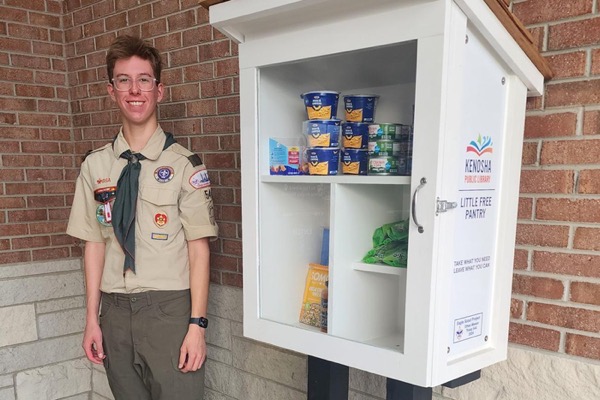Our Northside regulars may have noticed there is a new addition to the front entry of the library: a free little pantry! This is the work of a local Eagle Scout, Ethan Mason, who built these pantries for the library in support of our united efforts to fight food insecurity in Kenosha. These free little pantries are available 24/7 at Northside, Southwest, Simmons, and Uptown branches. Community members are always welcome to take food as needed, or leave non-perishable items.
Below is an interview with Ethan, where we asked him a bit more about his work on this project:
What inspired you to create a free little food pantry as your Eagle Scout project?
When I started thinking about my project, I was inspired to find something that would benefit Kenosha Public Library. As I spent a lot of time there as a kid, I wanted to do something to give back to the libraries. The library wanted pantries built but didn’t know who would be able to do it and I wanted to do something to help. It worked out perfectly!
How did you involve other people, such as fellow scouts, volunteers, or local businesses?
I involved others in a variety of ways. During the fundraising phase of my project I presented to the VFW Post 1865 and the Marine Corps League Detachment 352, I applied for a grant from the Youth as Resources board, and I held a fundraiser at the Culver’s in Pleasant Prairie. I brought volunteers from my Boy Scout troop to help at the presentations and the fundraiser. During construction, volunteers from my troop came to help and Creative Designs Custom Signs donated the signage. Finally, I involved community members through fundraising and food and hygiene drives. I received a lot of support and I am so grateful to everyone who has contributed.
How did you approach the design to make sure the pantry would be both functional and durable, especially given the weather conditions it will face outdoors?
When thinking about the construction of the pantry and when shopping I made sure to pick materials that would hold up to the elements. For example, I picked weather-resistant paint and stronger plywood so that the weather would not be a problem. In terms of structural stability, I used a plan that I found online for reference with the interior shelves serving as structural supports for the walls. As a last method of ensuring the pantries’ durability, I made sure to seal all possible seams, including doors and corners.
What part of building the pantry are you most proud of? Was there a particular aspect of the build that you feel showcases your craftsmanship the best?
I am definitely the most proud of the cedar shingles on the pantries’ roofs. The boxes looked good before the shingles, but after adding the shingles they really gained a new life and character. I feel like the shingles make the pantries look unique and interesting and I think it was really fun figuring out how to arrange them as well. Overall, the cedar shingles were my favorite part of the construction.
What do you hope people take away from the pantry, both in terms of how they contribute and how they use it?
I really hope that people see the pantries the way that I see them now, which is both as a way of getting help if you need it as well as a way of giving back to the community if you want. I think both of those aspects add a lot of value and I am hopeful that this project will help a lot of people.
What leadership skills did you develop during this project that you didn’t expect?
During this project, especially when fundraising and leading construction sessions with volunteers, I noticed myself getting a lot more confident. When I fundraised I did a lot of presentations to charitable organizations in the community. This helped me to gain confidence speaking in front of people. When leading construction I had to really know what I was doing and what I was planning. This helped me grow accustomed to getting more prepared in general. I think these are really important skills that will benefit me in the future.
How has this project impacted your personal view on giving back to your community?
I have always believed that it is important to give back to the community. However, while working on this project I have seen that there are many different ways to help, be it leading a project or volunteering on a project or simply donating to help it along the way. Big or small, all the ways to help are important and there is always a way to make a difference.

What lessons have you learned that you would want to share with people who want to start a community service project of their own?
I’ve learned so many lessons from this project. I think there are a couple things I would say to someone starting their own service project. First of all, I would say don’t be afraid to put yourself out there and do something that you might not be comfortable with yet. It’s part of the learning process and it will benefit you a lot. One thing I feel I struggled with at times was keeping in mind all the moving parts. To help with this, I would recommend thinking through the entire project step by step, even what seems obvious. Finally, remember to reach out to others in your community! There are so many people that are interested in helping out, and working with others makes things run a lot smoother!


